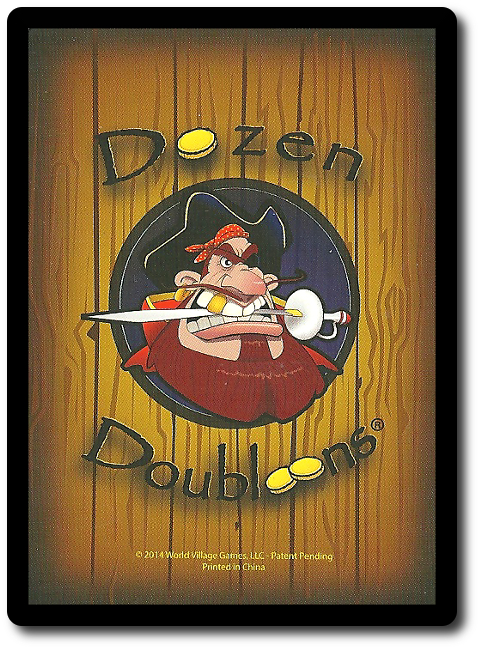
The Basics:
- For ages 5 and up (publisher suggests 7+)
- For 1 to 4 players
- Approximately 10 minutes to complete
Geek Skills:
- Counting & Math
- Logical & Critical Decision Making
- Hand/Resource Management
Learning Curve:
- Child – Easy
- Adult – Easy
Theme & Narrative:
- If a pirate is to be wealthy, they best be crafty
Endorsements:
- Gamer Geek rejected!
- Parent Geek approved!
- Child Geek approved!
Overview
When it comes to boarding a ship and taking its plunder, every pirate knows their job. The captain commands and the crew obeys. When the stolen booty is aboard and the ship is safely at sea, the real danger begins. Pirates love their treasure and will do anything to keep it. Rather than have his crew fight among themselves, the captain has his men divide the loot by playing cards. Pull up a chair and come claim your share!
Dozen Doubloons, designed by Alan Anderson and published by World Village Games, is comprised of 55 cards and 45 Doubloons (plastic coins with a skull and crossbones on one side and a treasure chest on the other). The cards are as thick and as durable as your standard playing card. The Doubloons are thin, but durable enough to not break during game play. There isn’t much in the way of artwork for the game, except for an illustration of a spilled bag of coins, a treasure chest, a pirate flag, and a pirate parrot.
Game Set Up
Note: The standard game allows for 2 to 4 players to enjoy in some pirate fun, but there is also a solitaire variant for those captains without a crew. The solo game rules are summarized in the “Game Variants” section of this review.
To set up the game, first shuffle the deck and cut to see which player goes first. Traditionally, the player who cuts to the highest card wins, but do what makes you happy.
Second, give the deck to the first player and then they shuffle the deck one more time. Deal out 4 stacks containing 5 cards each to the middle of the playing area. The first 4 cards in each stack are face-down, but the fifth card is face-up.
Third, deal 4 cards to each player, face-down. Players should look at their cards, but keep them hidden from their opponents.
Fourth, place the remaining cards face-down next to the stacks. This is the draw deck for the duration of the game. Leave room for a discard stack.
Fifth, leave the Doubloons within easy reach of all the players or have one player act as “Banker”.
That’s it for game set up. Time to get some gold!
The Lure of Treasure
Dozen Doubloons is played in turns with no set number of turns per game. A player will take up to 3 actions on their turn. The actions that can be taken are summarized here. It’s important to note that a player will only ever have 4 cards in their hand at maximum. This might seem limiting, but the player can also use the 4 face-up cards in the stacks found in the middle of the playing area. That is until they become blocked.
A player’s goal is very straight forward: collect Doubloons. This is done using the below actions, but not all actions will allow the player to collect Doubloons. A player can acquire treasure by doing the following:
- Collect 1 Doubloon by combining cards with a total number value of “12”.
- Collect 1 Doubloon when the player depletes one of the 4 stacks.
- Collect 2 Doubloons by playing a “Treasure Chest” number card (the card’s number value is “12”).
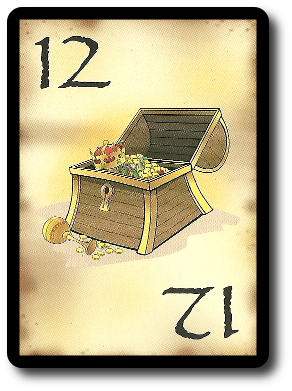
Note: Players can use cards in their hand and any face-up cards in the 4 stacks in the middle of the playing area. If a player ever takes a card from the 4 stacks, they immediately flip over the next card so it’s face-up. If a player should ever use all the cards in their hand before they are done with their turn, they immediately draw 4 new cards from the draw deck. This does not count as an action.
Action: Combine Cards
The cards have number values from 1 to 12. If the player can combine up to 3 numbered cards with or without a Wild card (which can be any number) with a combined total of “12”, the player can collect 1 Doubloon. The cards can come from the player’s hand, any card that is face-up in one of the 4 stacks, or a combination of the two.
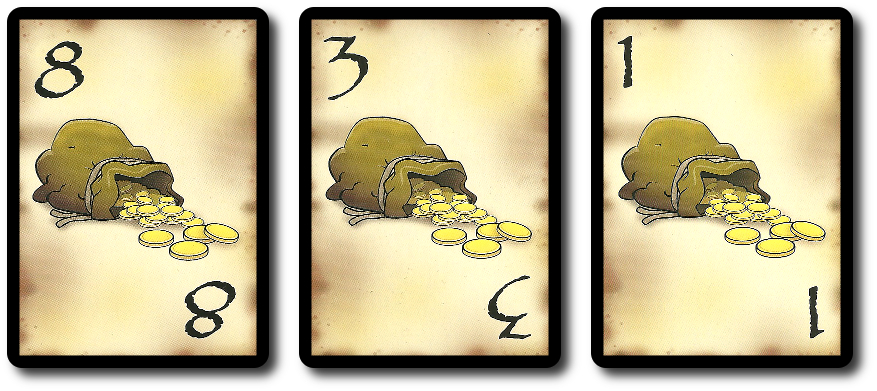
Action: Pirate Block!
Players can use the Block card in their hand or pull the card from one of the 4 face-up stacks. If the player wants to use it, they take the card and place it in front of an opponent, but only if the opponent does not have a Block card in front of them already (you can only block an opponent once). The blocked player must now select a stack in the middle of the playing area and place it in front of them. This is the only stack of cards the blocked player can use in addition to their hand of cards. However, other players can pull from the stack as long as they are not also blocked. Once the stack in front of the player is gone, they can go back to pulling cards from any stack.
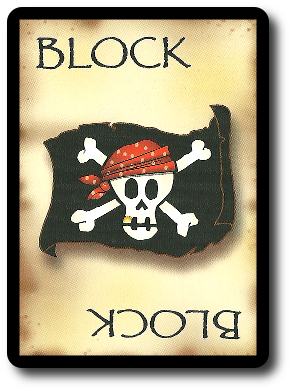
Action: Go Wild!
A Wild card can represent any number value from 1 to 12, but it can also be used for other things.
- Play a Wild card to represent any numbered card value.
- Play a Wild card to remove a Block card and the accompanying stack of cards. The Wild and Block card are discarded, but any cards in the stack remain in play and go back to the middle of the playing area.
- Play a Wild card with a “1” or a “2” valued number card on an opponent. The opponent must give the player a number of Doubloons equal to the number card value used. Both the Wild and the number card are then discarded. Wild cards can be assigned the value of “12”, but cannot be used to collect 2 Doubloons like the “Treasure Chest” number card.
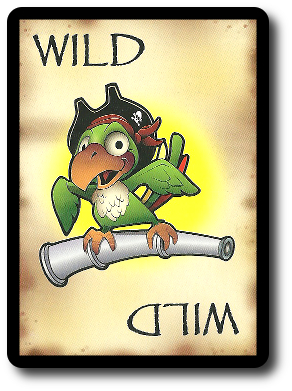
Action: Discard
The player can discard 1 card from their hand and draw 1 card immediately to replace it.
After the player has taken 3 actions, their turn is over. The last thing a player does on their turn is draw back up to 4 cards in their hand. The next player in turn order sequence now goes.
Restock the Stacks
There will always be 4 stacks of cards providing 4 face-up cards. If a stack is depleted, draw 5 new cards, placing the first 4 cards face-down and the fifth card face-up. In this way, players will always have 5 to 8 cards to play with during their turn.
The same goes for the draw deck. If the last card of the draw deck is taken, shuffle the discard pile to create a new draw deck.
Treasure Triumph!
The game continues with players taking 3 actions per turn until 1 player collects a total of 12 or more Doubloons. This player has earned their share of the treasure!
Game Variants
Dozens and Dozens of Doubloons
A single game of Dozen Doubloons goes pretty quickly. You might find yourself wanting to play several games in a row. The winner of each game keeps 1 Doubloon and sets it aside. After all the games are played, count the Doubloons kept after each win. The player with the most Doubloons wins.
A Pirate Crew of One
The solitaire version of the game plays very differently than the multi-player version. Instead of collecting Doubloons, the player is attempting to exhaust 6 stacks of cards in the middle by combining up to 3 cards with an added total of “12”. The player will also hold the remaining cards in their hand and will draw from it if they are unable to create a combined value of “12” using the stacks in the middle of the playing area. These drawn cards can be used, but they also hurt the player. If all 6 stacks are exhausted before the draw deck in the player’s hand is exhausted, they win. If not, they lose. For a bigger challenge, players can attempt to beat the game by removing key cards, such as the Wild cards.
To learn more about Dozen Doubloons, visit the game’s website.
Final Word
The Child Geek quickly learned and began to play the game. At first, I was concerned that our younger players would have a hard time playing, but if they did, they never showed it. The key to playing well is making certain a player can add numbers. If a player can count up to “12”, they can play Dozen Doubloons. This allowed us to successfully play the game with gamers as young as 5-years-old. According to one of our youngest players, “I like this game because I can block you and take your gold.” Which is pretty much what every 5-year-old yearns for; the ability to pester parents and steal their stuff. An older Child Geek said, “I like the game because it plays fast and you can always do something. You are never stuck.” True, but a player can be forced to draw cards for their entire turn because they can’t grab a Doubloon or drop a Block. Didn’t seem to matter, though, as all the Child Geeks enjoyed themselves. When the gold were collected, all the Child Geeks voted to approve Dozen Doubloons.
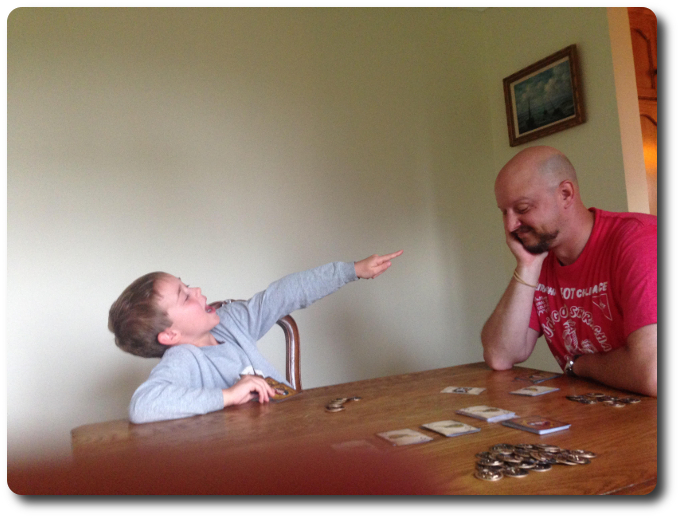
The Child Geeks mostly picked on the Parent Geeks
The casual gamer and the non-gamer Parent Geeks were as big a fans of Dozen Doubloons as the Child Geeks. They found the game to be light and easy to enjoy, yet challenging enough to keep everyone at the gaming table engaged. According to one Parent Geek, “I like the game. Really simple when you think about it, but there are times when you have to carefully consider what you want to do because you and an opponent are tied for victory.” There are moments in the game when it feels like it will all come down to just one more round of game play or a single card will mean victory or defeat. These moments are a lot of fun for everyone at the table. Another Parent Geek said, “I like it. Not sure it really has anything to do with pirates, but I like it.” Dozen Doubloons doesn’t have a strong pirate theme, but a theme of any kind would be unnecessary for this game. The veteran gamer Parent Geeks did not care for Dozen Doubloons, finding it to be too light and somewhat brainless. According to one such Parent Geek, “I think this is a great game for casual gamers and the kids, but for any gamer who wants a game with a lot of depth and more decision making, Dozen Doubloons is just not a fun game to play.” When the games were over, the majority of Parent Geeks voted to approve Dozen Doubloons.
The Gamer Geeks didn’t care for Dozen Doubloons at all. According to one Gamer Geek, “This is not a gamer’s game at all. All you do is add to 12 over and over and over again. This game bores me to tears.” Another Gamer Geek said, “A good game for kids or for players who want to play a game that requires little in the way of thinking, but for me, I see no reason to ever play this game again.” The Gamer Geeks played both the multi-player and the single-player versions of the game and never once changed their mind. Dozen Doubloons is just not a gamer’s game. All the Gamer Geeks voted to reject Dozen Doubloons.
Depending on your poison, Dozen Doubloons provides a light game for 2 or more players or a single-player. In the multi-player game, players must attempt to grab as many Doubloons as possible or do everything they can to hinder their opponents from doing so. Players don’t have to think very hard, making it a very casual game. The single-player game has the same level of intensity, but the focus is on breaking stacks down before the draw deck is exhausted. No Doubloons to be won, but the same type of thought process goes into the card plays, minus any attempts to trip up an opponent.
A player need not be a math wiz to play Dozen Doubloons. A calculator is simply not necessary. What is necessary is the ability to logically think through a player’s turn. A player needs to consider their options and possible options to be had in the future, but such considerations are not difficult to work through. The game will never make a player break a sweat, but they might grumble out of frustration when they don’t have the right cards.
Overall, I found Dozen Doubloons to be simply “OK”. My little geeks love playing it and it’s not a game that takes very long to complete. This has allowed me to play several games of Dozen Doubloons in a row before bedtime or when my kids just need to stop running around. The game also works very well as a starting game for the evening before moving to more complicated games. Best of all, the game does require critical thinking and math, but being stronger in either doesn’t give the player a significant advantage. This allowed my youngest little geek to play with his older siblings and adults without fear of being out skilled.
Not going to lie. Dozen Doubloons is light on game play and even lighter on pirate theme, but the game works and plays well enough to entertain casual players and non-gamers alike. Both young and old enjoyed it and could play together at the same table as equals. That’s pretty cool. If the game sounds interesting to you, I encourage you to give it a try.
This game was given to Father Geek as a review copy. Father Geek was not paid, bribed, wined, dined, or threatened in vain hopes of influencing this review. Such is the statuesque and legendary integrity of Father Geek.



